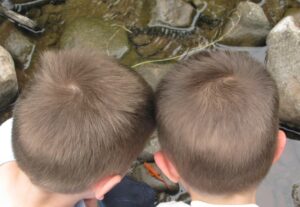
Sep 2, 2014 – Turn on the 3D Screen of Nature!
After working on my computer for about 3 hours I felt restless and anxious. I knew what I needed – a good dose of exercise in nature. We can imagine how children must feel closed up in a classroom, and how mothers and fathers feel closed up in an office. So I went for a walk at Benicia State Park, short drive from home. Within 10 minutes I was hearing a pheasant’s call, a hummingbirds wings, a frog croaking (yes, even without water); I felt the wind in my face and I saw a variety of textures in the cattails and fig trees. I was refreshed!
WE NEED TO JUST OPEN THE DOOR AND GO OUT!
Nature has a serious competitor these days – the screens with the fast paced games and the internet with the whole world available. Games stimulate the brain and nervous system with high speed neuronal connections or sometimes misconnections – nature does the opposite. Being in nature slows down the mind/brain system and creates a 3D depth experience as we smell, hear, see, touch and feel. Being in nature is healthy for us, all of us.
In his book: Last Child in the Woods, Richard Louv shares research on the benefits of nature, and the hazards for children who do not have access to nature – such as NDD – NATURE DEFICIT DISORDER, which the author describes as “diminished use of the senses, attention difficulties, and higher rates of physical and emotional illness.” (pg 36) Children who receive healthy doses of NATURE experience increased attention, more stable emotions and seem more peaceful and happier when they are brought into nature.
There are over 100 studies that point to stress reduction through being in nature. Even a room with a view of nature can help protect children against stress. Why do children “day dream” as they sit in the classroom looking out the window at a bird in a tree, or the clouds flowing across the sky? They are healing themselves (and they often get in trouble for doing this). When children daydream they are actually reducing what has been called: DIRECTED ATTENTION FATIGUE OR COGNITIVE WEARINESS. How many of us have felt our stress just flow away as we walk by a creek, or on the beach by the ocean, or pet our dog or cat or even watch fish.
Several other areas that being in nature encourages for our children:
1. Heightens their basic senses – seeing, hearing, smelling, feeling, increasing safety awareness by accentuating their natural ability to “pay attention” to what is around them in their environment. Senses are a child’s primal first line of self-defense. Encouraging “nature smart” awakens a hyperawareness by becoming sensitized to and aware of their surroundings;
2. Promotes the innate desire to explore – curiosity, and the desire to understand;
 3. Increases the feeling of being emotionally centered – crawling, walking or running on grass or the sand on the beach gives a connection with the physical aspects of life creating a deep feeling of being a part of the whole. And there is even some research which shows bare feet connection with the earth or grass can help balance the electrical system of our bodies;
3. Increases the feeling of being emotionally centered – crawling, walking or running on grass or the sand on the beach gives a connection with the physical aspects of life creating a deep feeling of being a part of the whole. And there is even some research which shows bare feet connection with the earth or grass can help balance the electrical system of our bodies;
5. Encourages brain development of categorization and patterns as children differentiate between the unending variety of rocks, trees, leaves, clouds, animals, the stars;
6. Creates a sense of stewardship – taking care of the earth and her creatures;
7. Facilitates deep understanding of the cycles of life – the seasons, the cycles of the moon, life and death of animals and humans;
8. Can allow for the welling up of a sense of awe of God who inhabits nature and created the patterns which can be found in nature.
BRINGING NATURE TO OUR CHILDREN AND OUR CHILDREN TO NATURE
Making nature a part of the home can be as simple as having a “nature altar” – a space in your home where kids of all ages can put a special rock, or branch, or pinecone they have found or finding a safe place for that special found stick. Research shows that one of the first and most favorite treasured toys of a child is a stick. Here are some suggestions for facilitating interaction with nature:
Research shows that one of the first and most favorite treasured toys of a child is a stick. Here are some suggestions for facilitating interaction with nature:
* Have some tools on hand such as a bug jar, a small fish net, a butterfly net, shoebox for collections. Live with an animal of some kind, even it is only a goldfish.
* Be sure there are times when the TV, the computer, the electronic games are off, so the sounds of the outside can come in.
* Read stories about animals.
* Encourage them to experience “constructive boredom – not the boredom which comes from the emptiness of computer games, but boredom which comes from the time and space to do NOTHING, to allow their imaginations free range.
* Allow controlled risk-taking such as climbing a tree or a rock. Let go of your own fears of your child being in nature, but teach them to be aware in nature – to listen for the rattle of the snake, the calls of the coyote, the “something” in the bush; to be safe in nature and get in touch with the “gut” feelings about what is OK and what poses a danger.
 * Getting DIRTY is OK. Nature is not necessarily clean, but it is usually healthy. In fact looking at DIRT from a scientific point of view, immunologists and neuroscientists have proposed that the sharp rise in asthma and allergy over the past 25 years might stem from “living too clean”. These researchers hypothesize that when we are exposed to harmless micro-organisms in our environment our immune system is trained to ignore benign molecules like pollen or dander on a pet. Inhaling a good dose of Mycobacterium vaccae by playing in dirt, gardening or taking a walk in nature might also increase serotonin-producing neurons (the feel good cells) in the brain. These bacteria might be responsible for “gardener happiness”.
* Getting DIRTY is OK. Nature is not necessarily clean, but it is usually healthy. In fact looking at DIRT from a scientific point of view, immunologists and neuroscientists have proposed that the sharp rise in asthma and allergy over the past 25 years might stem from “living too clean”. These researchers hypothesize that when we are exposed to harmless micro-organisms in our environment our immune system is trained to ignore benign molecules like pollen or dander on a pet. Inhaling a good dose of Mycobacterium vaccae by playing in dirt, gardening or taking a walk in nature might also increase serotonin-producing neurons (the feel good cells) in the brain. These bacteria might be responsible for “gardener happiness”.
OPEN THE DOOR AND GO OUT AND BRING NATURE IN
August 30, 2014

